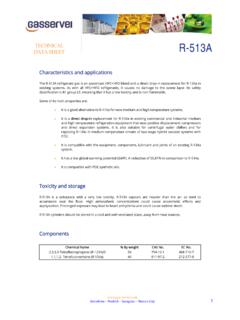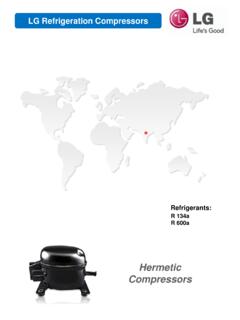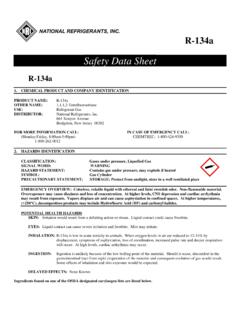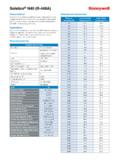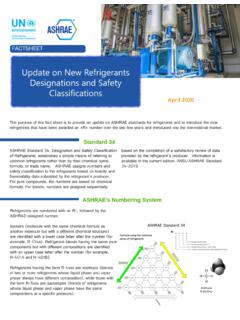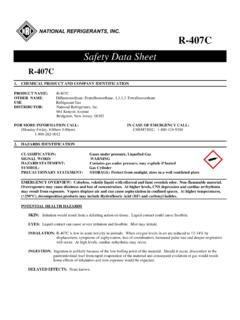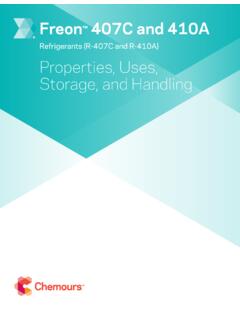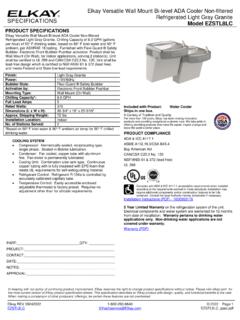Transcription of Hazards during the Repair and Maintenance of Refrigeration ...
1 Department of Labor t t (800) 321-OSHA (6742)Fact SheetShipyardEmploymentHazards during the Repair and Maintenance of Refrigeration Systems on VesselsThe Repair and Maintenance of Refrigeration systems can present Hazards to both workers servicing these systems and those in the general area. The two main types of hazardous refrigerants used in vessel Refrigeration systems are ammonia and halocarbons (the most commonly recognized is Freon ). The latter include chloroflourocarbons (CFCs), hydroflourocarbons (HFCs), and hydrochloroflourocarbons (HCFCs), such as chlorodifluoromethane (R-22) or difluoromonochloromethane (R-134A). Worker exposure to these compounds may occur during Maintenance and Repair activities, or as a result of leaks. Depending on which refrigerant is used, different precautions may be required. AmmoniaAmmonia, in liquid or gas form, can present Hazards to workers skin, eyes, nose, and lungs.
2 Liquid ammonia is a clear fluid that evaporates quickly at room temperature. As a gas, ammonia is colorless and has a strong odor that is suffocating, pungent, and penetrating. It is much lighter than air, so if ammonia gas escapes from a Refrigeration system or a storage container, it may collect in high areas or ceilings. Liquid releases can form aerosols that may tend to accumulate at low points. Therefore, it is important to take atmospheric readings at various locations within a space to ensure that it is safe for workers. While ammonia has a low odor threshold (as low as 2 ppm), which makes it easy to detect even in low concentrations, workers who have been exposed to ammonia regularly (or repeatedly) may experience a significant reduction in their ability to detect ammonia by smell. Exposure to ammonia at 300 ppm is immediately dangerous to life and health.
3 Where there is a potential for overexposure to ammonia, employers must provide workers with proper safety equipment and ensure its use (29 CF R (b)). Personal protective equipment (PPE) should be used when there is a possibility of exposure above 50 ppm. See 29 CFR (29 CFR ) for detailed information on proper respiratory protection. Ammonia is flammable at all concentrations and explosive between 15% and 28% (150,000 - 280,000 ppm) in air. If ammonia is released in an enclosed space with an ignition source, an explosion may : Amy Sly, Sound Testing, of Refrigeration systems aboard Department of Labor t t (800) 321-OSHA (6742)Employers with systems containing 10,000 pounds or more of ammonia must follow the requirements in 29 CFR (Process safety Management of Highly Hazardous Chemicals) for controlling Hazards associated with a release of ammonia.
4 Employers must: 1 Identify Hazards through a process hazard analysis and ensure that they are controlled to protect workers (29 CFR (e)). The hazard analysis must be revalidated at least every five years (29 CFR (e)(6)). Develop and implement written operating procedures for workers on vessels to follow based on the results of a detailed hazard analysis (29 CFR (f )(1)). OSHA requires that these procedures be reviewed as often as necessary and certified as current and accurate at least annually (29 CFR (f)(3)). Verify that Refrigeration equipment complies with good engineering practices and that it is operated in a safe manner (29 CFR (d)(3)(ii), (iii)). Train maritime workers on the safety and health Hazards associated with using ammonia, on emergency operations (including shutdown), and on safe work practices that apply to their job tasks (29 CFR (g)(1)(i)).
5 Check on each worker who works alone at regular intervals by sight or verbal communication, including at the end of the job assignment or workshift, whichever occurs first (29 CFR ).Common Exposure Thresholds for AmmoniaRangeHazards2 55 ppmNormal range of odor thresholdNote: If the smell of ammonia is detected and/or you experience eye irritation, leave the area immediately and notify the appropriate ppmTingling or burning in eyes, nose, or throat; can cause watering of eyes, sneezing, and coughing300 ppmSevere irritation of eyes, nose, or respiratory tract, which becomes intolerable after a few minutes; difficulty breathing; possible burning in lungs (IDLH level)2,000 ppm or moreCan be fatal after a few breaths1 The Process safety Management standard has 14 enforceable elements. This summary highlights certain key requirements of 29 CFR , but employers covered by the standard must comply with all additional information on worker safety when exposed to ammonia see: OSHA safety and Health Topics Page Ammonia Refrigeration OSHA eTool - Ammonia RefrigerationHalocarbons The use of certain halocarbons (CFCs and HCFCs) is being phased out in the United States, although it is expected that these refrigerants will not be fully removed from use until around 2030.
6 In addition to trying to use alternative refrigerants that are safer for workers and the environment, employers still must assess work activities to determine if such Hazards are present, or are likely to be present (29 CF R ( b)). Where a workplace assessment determines that using PPE is necessary, the employer must equip affected workers with the type of PPE that will protect them from the identified hazard(s) and explain its selection in a manner that each worker understands (29 CFR (b)(1) and (2)).Halocarbons, which exist both as a liquid or gas, are not easily ignited and do not burn rapidly if ignited. Halocarbons are heavier than air, which can lead to asphyxiation in a confined space due to the displacement of oxygen. As a liquid, many of these colorless compounds are volatile and give off vapors with a faint sweet odor.
7 Overexposure to halocarbons can cause dizziness due to the lack of oxygen, which is a warning sign of the onset of asphyxiation. At higher exposure levels and with long periods of worker exposure, central nervous system depression, cardiac arrhythmia, and death may performing hot work in the presence of halocarbons, decomposition products such as hydrochloric acid (HCI), hydrofluoric acid (HF) and carbonyl halides may form. These compounds can be toxic at very low concentrations. All hot work should be stopped during any halocarbon refrigerant leak to prevent worker exposure to such toxic compounds, as well as the risk of fire or halocarbon refrigerants are used in cooling systems and new, more environmentally friendly compounds are constantly being developed. Many of the newer halocarbon refrigerant replacements do not have Permissible Exposure Limits (PELs).
8 Depending on the refrigerant used, employers should consult the PELs listed in 29 CFR 1915, Subpart Z, or the manufacturer s safety data sheet (SDS). Some common halocarbons used as refrigerants include dichlorodifluoromethane (R-12), dichlorotetrafluoroethane (R-114), and trichlorofluoromethane (Freon 113). These specific compounds are assigned a PEL of 1,000 ppm. Refer to their common exposure thresholds below. Department of Labor t t (800) 321-OSHA (6742)Common Exposure Thresholds for Halocarbons (R-12, R-114, and Freon 113)RangeHazards1,000 ppmNormal range of odor threshold75,000 100,000 ppmAgitation and dizziness200,000 ppmDrowsiness, or unconsciousness300,000 ppm or moreCan be fatal after just a few breathsSafety Requirements and Recommended Best Practices for Ammonia- and Halocarbon-Based Systems Employers must provide and ensure that workers use appropriate protective equipment (such as impervious clothing, gloves, splash-proof safety goggles, face shields - eight-inch minimum) to prevent repeated or prolonged skin contact with liquid refrigerants (29 CF R (a)).
9 Employers must provide and ensure that workers wear appropriate respiratory protection determined to be necessary by a workplace hazard analysis (29 CF R ( b) and 4 (see 29 CFR ). Where atmospheric conditions are immediately dangerous to life or health (IDLH), such as during a leak, employers must provide workers with appropriately protective supplied-air respirators or escape-only respirators that meet the requirements of 29 CFR (d)(2). Air-purifying respirators, which would not adequately protect workers in IDLH atmospheres, may not be used. When workers responsibilities include responding to a possible refrigerant leak, employers must have a written emergency response plan in place (29 CFR (q)(1)). The plan must include an explanation of worker personnel roles, lines of authority (including designation of a senior official ), necessary training, communication protocols, and PPE (see 29 CFR (q)(2)(i) through (q)(2)(xii), and (q)(3)(i)).)
10 Note: All ignition sources must be secured and effective ventilation installed to rid the area of refrigerant vapors (29 CFR 19 15 .12 ( b) ( 2 )). Unprotected personnel may not return to the affected area, especially bilge areas, until the atmosphere has been tested and the space is determined to be safe (29 CFR (b)(3)). Verify atmospheric safety , using a detector tube or other appropriate instrument, to ensure that no dangerous level of halocarbon or ammonia is present (29 CFR (b)). In the event that a refrigerant leak occurs and there is no immediate way to identify or reasonably estimate worker exposure to the potential respiratory hazard, employers must consider the atmosphere to be IDLH and initiate the appropriate emergency procedures necessary (29 CFR (d)(1)(iii)). Use mechanical ventilation to bring concentrations of airborne refrigerants within the Permissible Exposure Limit (PEL)/Recommended Exposure Limit (REL) (29 CFR ).











